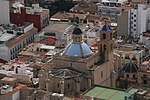Basilica of Santa Maria, Alicante
Basilica churches in SpainBien de Interés Cultural landmarks in the Province of AlicanteBuildings and structures in AlicanteEurope Roman Catholic church stubsMinor basilicas in Spain ... and 3 more
Roman Catholic churches in the Valencian CommunitySpanish church stubsValencian Community geography stubs

The Basilica of Santa Maria is the oldest active church in Alicante, Spain. It was built in Valencian Gothic style between the 14th and 16th centuries over the remains of a mosque. The basilica is composed from a single nave with six side chapels located between the buttresses. In 2007, by request of the city of Alicante to the Holy See, the church was promoted to the rank of basilica.
Excerpt from the Wikipedia article Basilica of Santa Maria, Alicante (License: CC BY-SA 3.0, Authors, Images).Basilica of Santa Maria, Alicante
Plaza Paseíto Ramiro, Alicante San Roque
Geographical coordinates (GPS) Address External links Nearby Places Show on map
Geographical coordinates (GPS)
| Latitude | Longitude |
|---|---|
| N 38.346166666667 ° | E -0.47930555555556 ° |
Address
Basílica de Santa María
Plaza Paseíto Ramiro
03002 Alicante, San Roque
Valencian Community, Spain
Open on Google Maps










